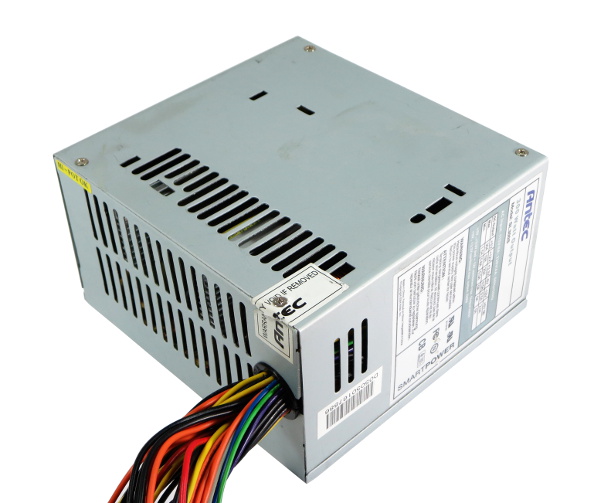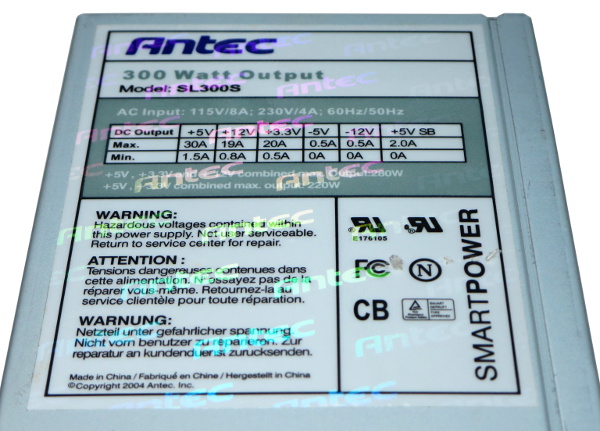PSU Repair: A Case Study
When your PSU won't start, most enthusiasts don't go beyond a paperclip or multimeter check. Today, we'll do a comprehensive repair of Antec's old SL300.
Background Story On Today's Patient
I originally purchased this power supply in 2005 when my Pentium III's supply blew up from power getting restored after an outage. I re-used the SL300 when I built my Core 2 Duo-based PC in late 2008. I had to re-cap its main outputs due to the the famous “Asus Anti-Surge” warnings shutting down the system in early 2010. After that, all seemed good again until mid-2014.
What follows may sound familiar to many of you: in May 2014, my PC would no longer turn on and I could not identify anything obviously wrong with the supply at the time. All voltages looked fine during the paperclip test, but the PSU would not stay on when connected to my machine. LEDs momentarily flashed on, the fans lurched forward and I heard an irregular hissing sound similar to water running through a faucet's strainer from the supply, then nothing. I had not changed anything in that PC in over a year, ruling out hardware changes and shorts from moving things around as suspects. Disconnecting everything except the motherboard also made no difference, ruling out dead peripherals beyond the motherboard. I opened the supply up for a quick look, and all of its caps still looked good with no apparent damage. Since I had no time to mess around with it and no suitable parts for the caps I didn't change the first time around, I shelved the SL300, put in an Antec VP450 I had bought on sale for $30 and my Core 2-based machine sprang back to life, confirming that I had a power supply issue.
Parts swapping is a crude troubleshooting method, but I cannot argue with results. For most people, including myself at the time, swapping in a presumably known-good component is often the quickest and most cost-effective solution after the paperclip and multimeter tests have turned out inconclusive.
A few months later, I popped the SL300's cover again and replaced the remaining original output caps; this did not help at all. In fact, the 5VSB supply ended up rising higher after I replaced the worst-looking one, and the main outputs no longer stayed on. None of the 5VSB components looked fried and everything seemed otherwise fine as far as my multimeter could tell. I tried touching up solder joints in case there may have been a cold joint somewhere, but that made no difference either. So, I dumped it in my pile of projects for later.
At the tail end of the year, I got the idea of loading the 5VSB rail using a crude current sink circuit and cranking current up until voltage dropped to 5.2V. This did allow the power supply to power up predictably, albeit at the expense of 10W worth of dummy loading. I would not be comfortable with this as a permanent fix, assuming the PSU would survive it, but I decided to call it good enough for occasional workbench use until I could go back in for a more permanent solution. That's exactly what I am aiming to do here.
On a related note, as absurd as it may sound, someone still lists the SL300 as new on Amazon for $125 at the time of writing and others are listing used units starting from $70. From what I discovered along the way, I would not buy a used (or new) SL300, even for $40. Buy the VP450 instead.
Get Tom's Hardware's best news and in-depth reviews, straight to your inbox.
Current page: Background Story On Today's Patient
Prev Page Power Supply Troubleshooting Next Page Preliminary Testing: The 5VSB Rail-
Nuckles_56 An interesting read, it was interesting following the process you used to troubleshoot the problemReply -
Crashman I used to do this for a living :)Reply
Don't tell my boss, I've managed to convince him that I'm only an expert at running benchmarks and writing about the results :) -
epsiloneri Disclaimers won't help. The people who will likely hurt themselves trying this are the same who lack the reading comprehension and self awareness to understand those disclaimers are directed at them. I admire you courage in publishing this.Reply
-
beetlejuicegr the truth is the paper clip and multimeter is all i can go in to psus. after all i haven't studied electricity or circuits or whatever.Reply
However i do hate to throw stuff earlier than it should, like you. -
C12Friedman I like this article and I fully agree with the conclusion. I've repaired a few PSU's but, for the most part I scavenge them anymore since I can't put them in a new system (nor would I want to) IMO they aren't really worth anything other than for on a test bench.Reply -
Mr A Daniel, I know next to nothing about electronics, and yet I could not stop reading this article. Fascinating! Thanks very much!Reply -
Urzu1000 This was a great article! It was informative, as well as interesting. Personally, I've only had one PSU fail on me so far. My brother-in-law's self-built computer had a really low-end Thermaltake PSU. 800W Bronze, and oh man, did that thing go out in a blaze of glory. Very loud popping, and smoke, and funny smells. When I ripped it out of the computer, there were burns inside the case. Miraculously, the other components remained unharmed, so I slapped in a new PSU (750W Gold Seasonic) and fired it up.Reply
Still working good, but I get black soot on my hands every time I open up that case. It's a black case, so it's hard to clean it off properly. -
Interesting article. I would have simply replaced the entire unit. You saw how to fix the failure, but how many units were damaged that you didn't see? A ticking time bomb that will eventually send some spike to your much more valuable hardware than a 10 year old PSU. Wasteful, yes. I get it. I don't like to waste either. And if it's on marginal hardware, fine. But on primary systems I'm not willing to take the risk. I'd rather throw away a 200$ part that has a 0.05$ repair solution, than risk frying 800$+ hardware.Reply
-
kalmquist "Antec's manufacturer (Channelwell in this case) got the live and neutral wires backwards, which means that in the “off” position, the neutral line gets opened and everything on the primary side becomes live instead of neutral."Reply
That's really bad--I doubt it is even legal to sell a power supply wired like that. I've never bought a CWT (Channelwell) power supply, and based on this I wouldn't buy one, except perhaps for a high end model where you might gamble that the company would exercise a bit more care.

